Effect of High Content of Waste Tire Rubber and Sulfur on the Aging Behavior of Bitumen
Abstract
:1. Introduction
2. Material and Methods
2.1. Materials
2.2. Aging Procedures
2.3. Rheological Property Tests
2.4. ATR-FTIR Test
3. Results and Discussion
3.1. Master Curves Result Analysis
3.1.1. Master Curves before Aging
3.1.2. Master Curves after Aging
3.2. TS Test Result Analysis
3.2.1. G* and δ before Aging
3.2.2. G* and δ after Aging
3.3. MSCR Test Result Analysis
3.3.1. Jnr and R before Aging
3.3.2. Jnr and R after Aging
3.4. Aging Resistance
3.5. ATR-FTIR Analysis
4. Conclusions
- The addition of sulfur to HCRMB leads to an increase in G*, R0.1, and R3.2 and a decrease in δ, Jnr0.1, and Jnr3.2, resulting in an improvement in the elasticity of HCRMB. Moreover, in the low temperature region, the G* master curves of 70# are higher than that of the HCRMB with different amounts of sulfur;
- The elasticity of 70# and HCRMB with different amounts of sulfur increases with aging. In addition, the RTFOT aging resistance and the PAV aging resistance of HCRMB is better than that of conventional RMB, and the increase in the amount of sulfur can improve the RTFOT aging resistance and the PAV aging resistance of HCRMB;
- The carbonyl group of conventional RMB is less affected by aging than that of HCRMB. Under the influence of aging, conventional RMB is more easily desulfurized than HCRMB, and sulfur cannot reduce the degree of oxidation of HCRMB after aging, but can inhibit the degree of desulfurization of HCRMB. Furthermore, the aging process of HCRMB with different amounts of sulfur is dominated by the degradation of polybutadiene, whereas there is a certain CR desulfurization in conventional RMB aging.
Author Contributions
Funding
Institutional Review Board Statement
Informed Consent Statement
Data Availability Statement
Acknowledgments
Conflicts of Interest
References
- Lo Presti, D.; Airey, G.; Partal, P. Manufacturing Terminal and Field Bitumen-Tyre Rubber Blends: The Importance of Processing Conditions. Procedia-Soc. Behav. Sci. 2012, 53, 485–494. [Google Scholar] [CrossRef] [Green Version]
- Thodesen, C.; Xiao, F.; Amirkhanian, S.N. Modeling viscosity behavior of crumb rubber modified binders. Constr. Build. Mater. 2009, 23, 3053–3062. [Google Scholar] [CrossRef]
- Thodesen, C.; Shatanawi, K.; Amirkhanian, S. Effect of crumb rubber characteristics on crumb rubber modified (CRM) binder viscosity. Constr. Build. Mater. 2009, 23, 295–303. [Google Scholar] [CrossRef]
- Szerb, E.I.; Nicotera, I.; Teltayev, B.; Vaiana, R.; Rossi, C.O. Highly stable surfactant-crumb rubber-modified bitumen: NMR and rheological investigation. Road Mater. Pavement Des. 2018, 19, 1192–1202. [Google Scholar] [CrossRef]
- Ibrahim, I.M.; Fathy, E.S.; El-Shafie, M.; Elnaggar, M.Y. Impact of incorporated gamma irradiated crumb rubber on the short-term aging resistance and rheological properties of asphalt binder. Constr. Build. Mater. 2015, 81, 42–46. [Google Scholar] [CrossRef]
- Kim, S.; Loh, S.; Zhai, H.; Bahia, H.U. Advanced Characterization of Crumb Rubber-Modified Asphalts, Using Protocols Developed for Complex Binders. Transp. Res. Rec. J. Transp. Res. Board 2001, 1767, 15–24. [Google Scholar] [CrossRef]
- Lo Presti, D. Recycled Tyre Rubber Modified Bitumens for road asphalt mixtures: A literature review. Constr. Build. Mater. 2013, 49, 863–881. [Google Scholar] [CrossRef]
- Bressi, S.; Fiorentini, N.; Huang, J.; Losa, M. Crumb Rubber Modifier in Road Asphalt Pavements: State of the Art and Statistics. Coatings 2019, 9, 384. [Google Scholar] [CrossRef] [Green Version]
- Veropalumbo, R.; Viscione, N.; Russo, F. Rheological and Mechanical Properties of HMA Containing Fly Ashes as Alternative Filler. In Proceedings of the 5th International Symposium on Asphalt Pavements & Environment (APE); Pasetto, M., Partl, M.N., Tebaldi, G., Eds.; Springer International Publishing: Cham, Switzerland, 2020; pp. 88–97. [Google Scholar]
- Picado-Santos, L.G.; Capitão, S.D.; Neves, J.M.C. Crumb rubber asphalt mixtures: A literature review. Constr. Build. Mater. 2020, 247, 118577. [Google Scholar] [CrossRef]
- Wang, S.; Huang, W.; Lin, P. Low-Temperature and Fatigue Characteristics of Degraded Crumb Rubber–Modified Bitumen Before and After Aging. J. Mater. Civ. Eng. 2022, 34, 04021493. [Google Scholar] [CrossRef]
- Wang, S.; Huang, W. Investigation of aging behavior of terminal blend rubberized asphalt with SBS polymer. Constr. Build. Mater. 2021, 267, 120870. [Google Scholar] [CrossRef]
- Wang, S.; Huang, W.; Kang, A. Laboratory evaluation of the properties of high-cured crumb rubber modified asphalt containing sulfur and polymer after the oxidative aging procedure. Constr. Build. Mater. 2021, 304, 124611. [Google Scholar] [CrossRef]
- Wang, S.; Huang, W.; Lin, P.; Wu, Z.; Kou, C.; Wu, B. Chemical, Physical, and Rheological Evaluation of Aging Behaviors of Terminal Blend Rubberized Asphalt Binder. J. Mater. Civ. Eng. 2021, 33, 04021302. [Google Scholar] [CrossRef]
- Jiang, Z.; Easa, S.M.; Hu, C.; Zheng, X. Understanding damping performance and mechanism of crumb rubber and styrene-butadiene-styrene compound modified asphalts. Constr. Build. Mater. 2019, 206, 151–159. [Google Scholar] [CrossRef]
- Xiang, L.; Cheng, J.; Kang, S. Thermal oxidative aging mechanism of crumb rubber/SBS composite modified asphalt. Constr. Build. Mater. 2015, 75, 169–175. [Google Scholar] [CrossRef]
- Liang, M.; Xin, X.; Fan, W.; Luo, H.; Wang, X.; Xing, B. Investigation of the rheological properties and storage stability of CR/SBS modified asphalt. Constr. Build. Mater. 2015, 74, 235–240. [Google Scholar] [CrossRef]
- Dong, F.; Yu, X.; Liu, S.; Wei, J. Rheological behaviors and microstructure of SBS/CR composite modified hard asphalt. Constr. Build. Mater. 2016, 115, 285–293. [Google Scholar] [CrossRef]
- Gedik, A.; Lav, A.H. Morphological evaluation and quantitative effect of sulphuric extension on B160/220 rheological behaviour at high temperatures. Constr. Build. Mater. 2016, 127, 457–465. [Google Scholar] [CrossRef]
- Gedik, A.; Lav, A.H. Analytical, morphological, and rheological behavior of sulphur-extended-binder. Can. J. Civ. Eng. 2016, 43, 532–541. [Google Scholar] [CrossRef] [Green Version]
- D’Melo, D.; Raju, S.; Bhattacharya, S.; Subramani, S. Self-assembly of amorphous sulphur in bitumen–sulphur mixtures and its impact on properties. Constr. Build. Mater. 2016, 126, 976–982. [Google Scholar] [CrossRef]
- Gladkikh, V.; Korolev, E.; Smirnov, V.; Sukhachev, I. Modeling the Rutting Kinetics of the Sulfur-extended Asphalt. Procedia Eng. 2016, 165, 1417–1423. [Google Scholar] [CrossRef]
- Zhou, T.; Xie, S.; Kabir, S.F.; Cao, L.; Fini, E.H. Effect of Sulfur on Bio-Modified Rubberized Bitumen. Constr. Build. Mater. 2021, 273, 122034. [Google Scholar] [CrossRef]
- Zhang, J.; Sakhaeifar, M.; Little, D.N.; Bhasin, A.; Kim, Y.-R. Characterization of Crack Growth Rate of Sulfur-Extended Asphalt Mixtures Using Cyclic Semicircular Bending Test. J. Mater. Civ. Eng. 2018, 30, 04018311. [Google Scholar] [CrossRef]
- Zhang, F.; Hu, C. The research for SBS and SBR compound modified asphalts with polyphosphoric acid and sulfur. Constr. Build. Mater. 2013, 43, 461–468. [Google Scholar] [CrossRef]
- JTG E20-2011; Standard Test Methods of Bitumen and Bituminous Mixtures for Highway Engineering. Research Institute of Highway Ministry of Transport: Beijing, China, 2011.
- Wang, S.; Huang, W.; Kang, A. Evaluation of Aging Characteristics of High-Viscosity Asphalt: Rheological Properties, Rutting Resistance, Temperature Sensitivity, Homogeneity, and Chemical Composition. J. Mater. Civ. Eng. 2021, 33, 04021149. [Google Scholar] [CrossRef]
- Hu, M.; Ma, J.; Sun, D.; Ling, S.; Lu, T.; Ni, H. Understanding the Aging Depth Gradient Distribution of High Viscosity Modified Asphalt under the Effect of Solar Radiation and Diffuse Oxygen. ACS Sustain. Chem. Eng. 2021, 9, 15175–15189. [Google Scholar] [CrossRef]
- Ābele, A.; Merijs-Meri, R.; Bērziņa, R.; Zicāns, J.; Haritonovs, V.; Ivanova, T. Effect of bio-oil on rheological and calorimetric properties of RTFOT aged bituminous compositions. Int. J. Pavement Res. Technol. 2021, 14, 537–542. [Google Scholar] [CrossRef]
- Chen, J.S.; Huang, C.C. Fundamental characterization of SBS-modified asphalt mixed with sulfur. J. Appl. Polym. Sci. 2007, 103, 2817–2825. [Google Scholar] [CrossRef] [Green Version]
- D’Angelo, J.A. The Relationship of the MSCR Test to Rutting. Road Mater. Pavement Des. 2009, 10, 61–80. [Google Scholar] [CrossRef]
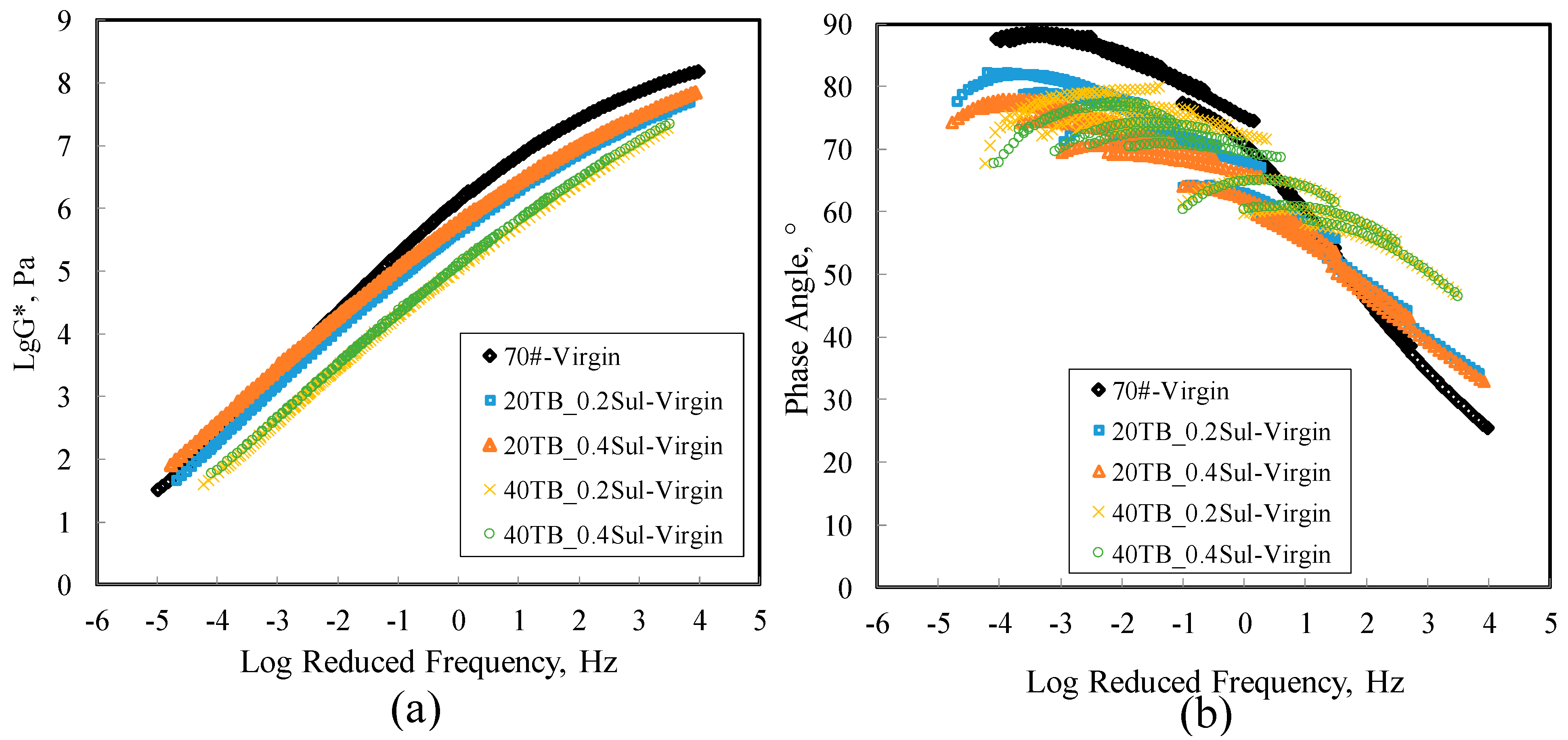
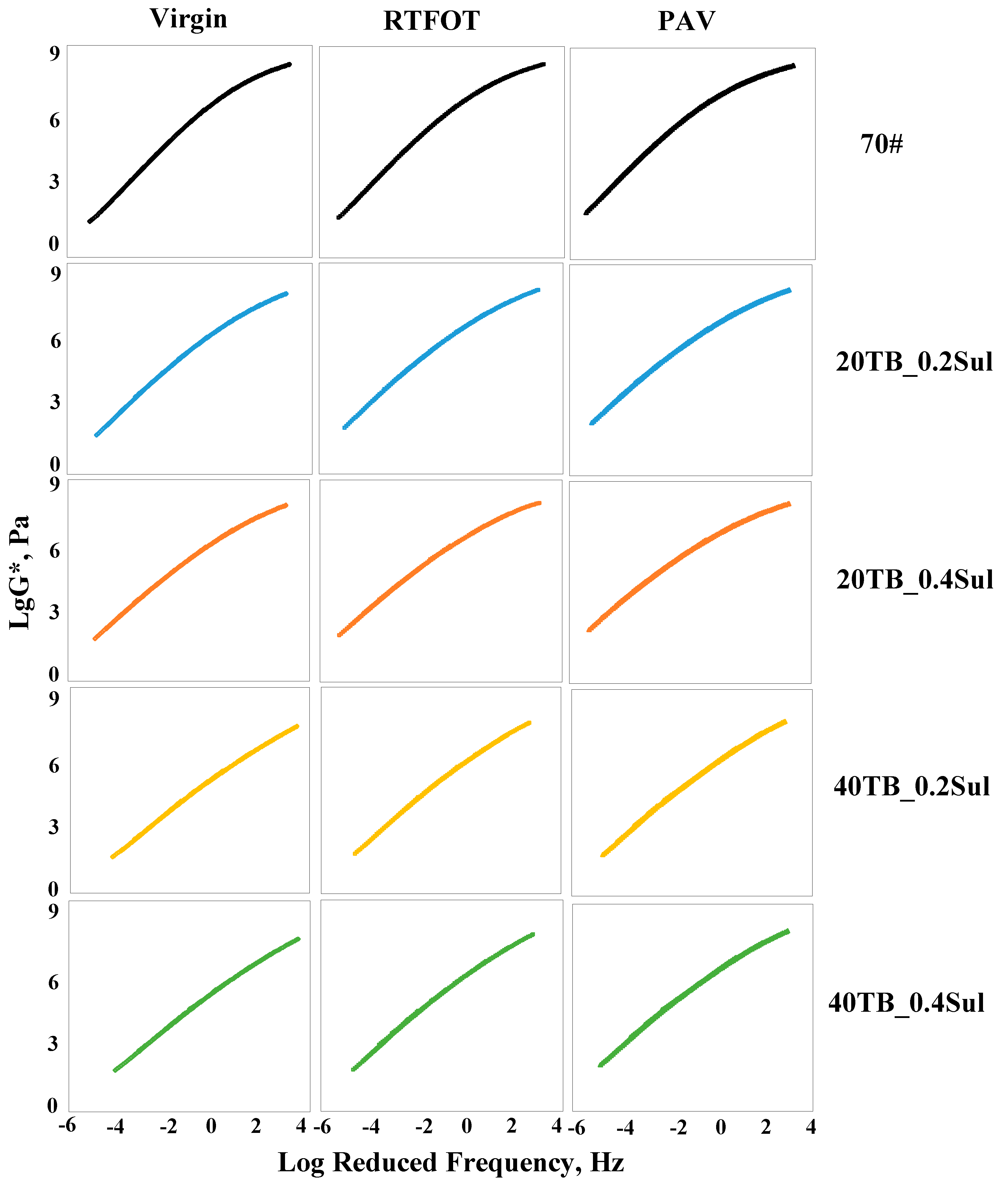

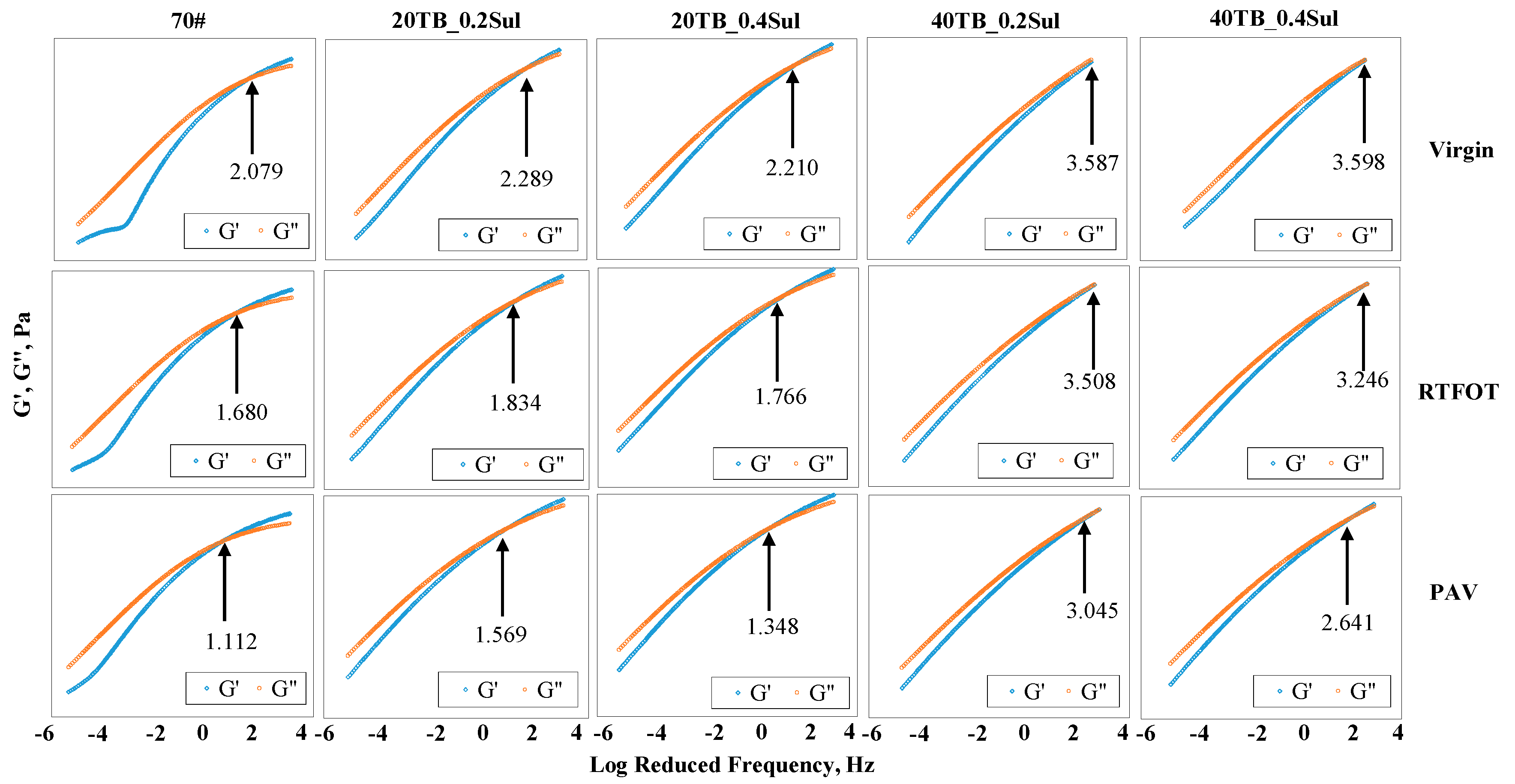
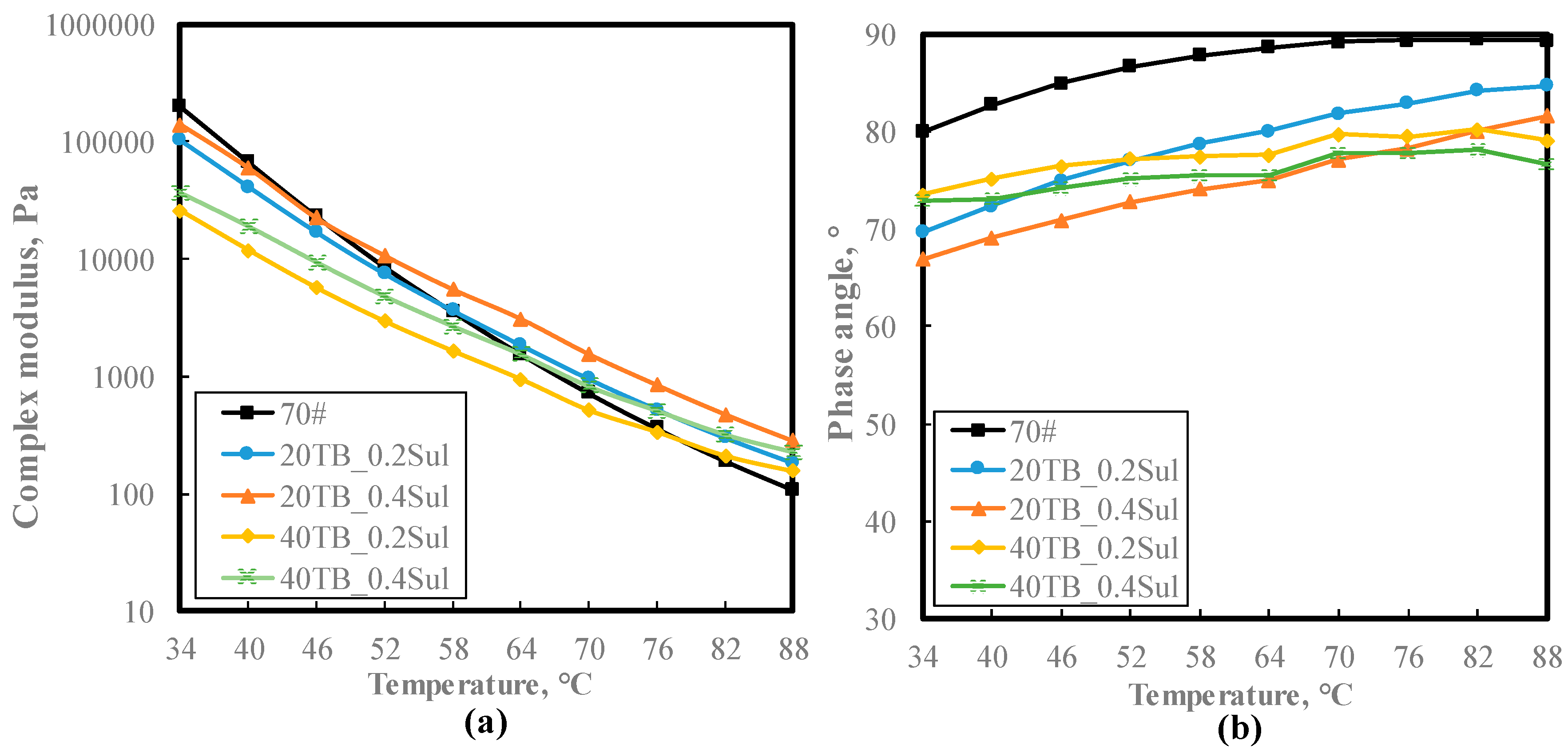
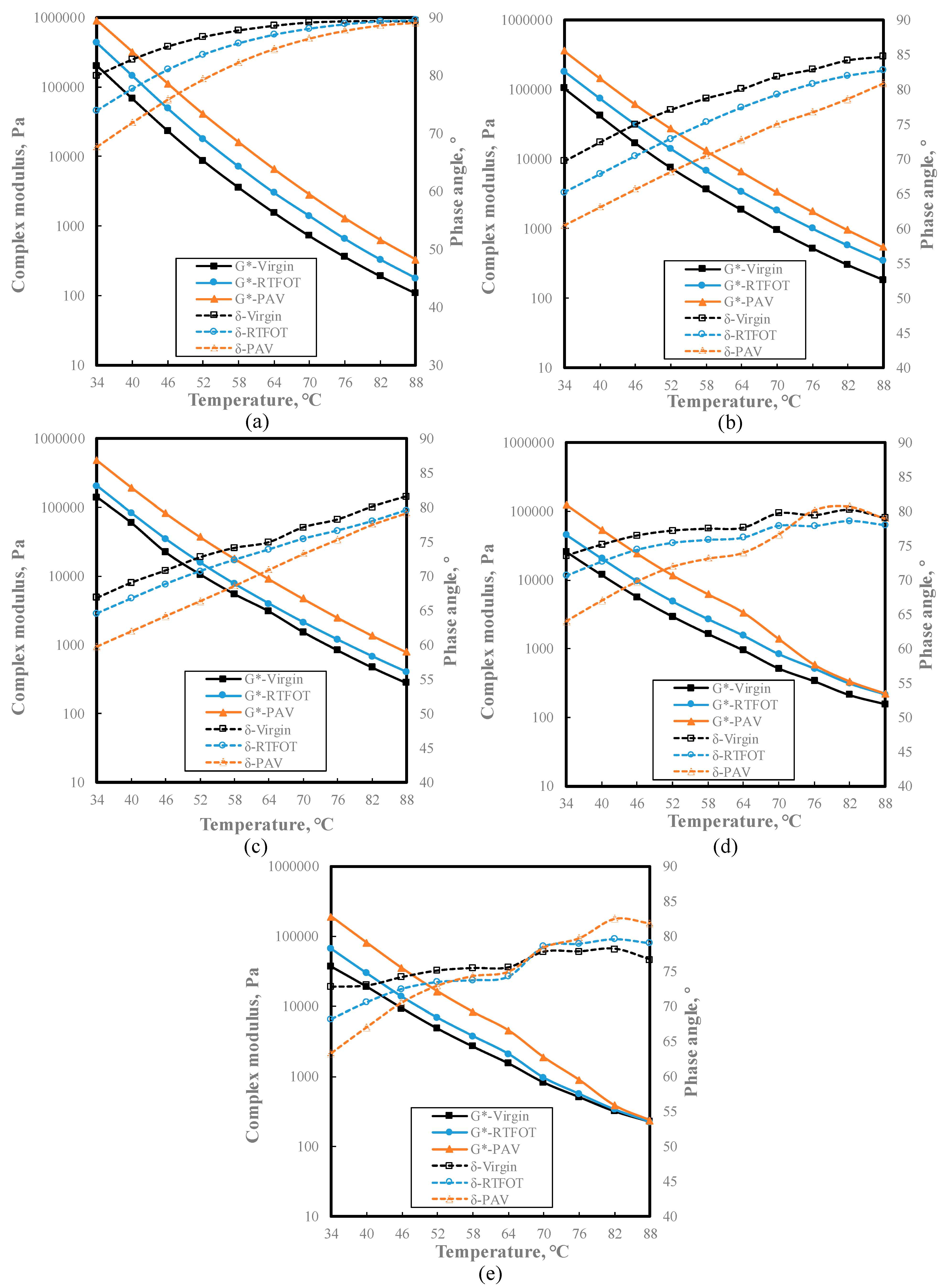


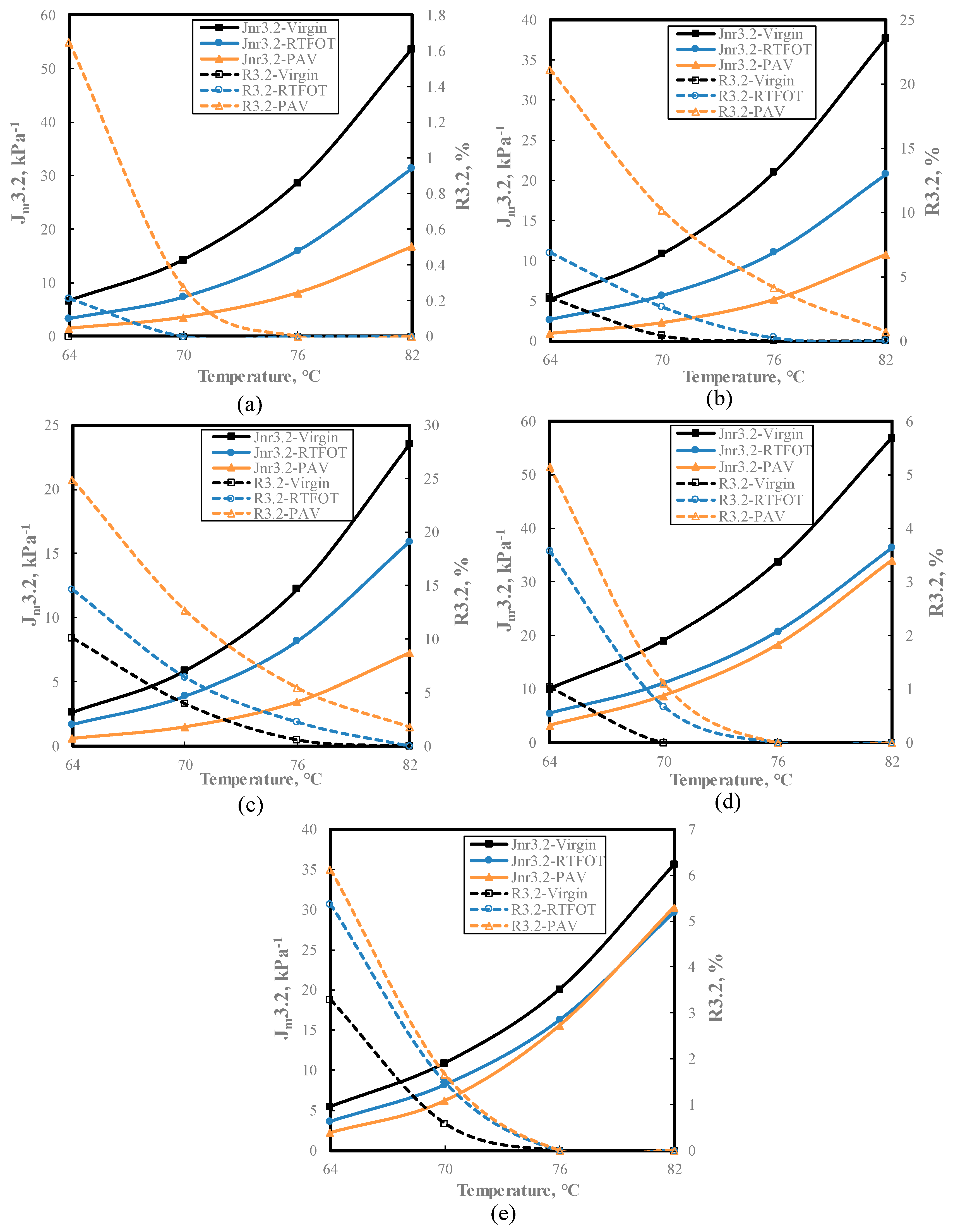
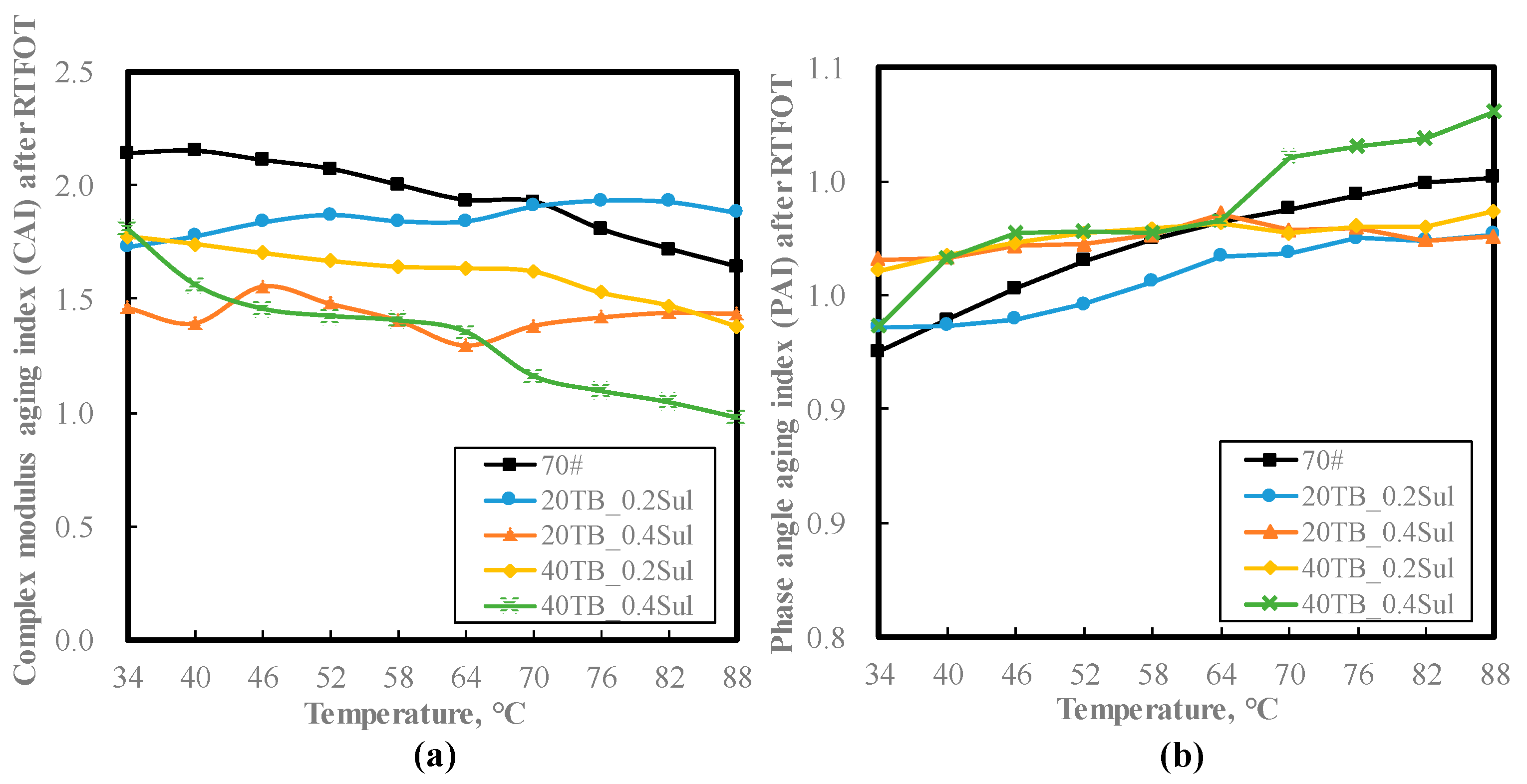
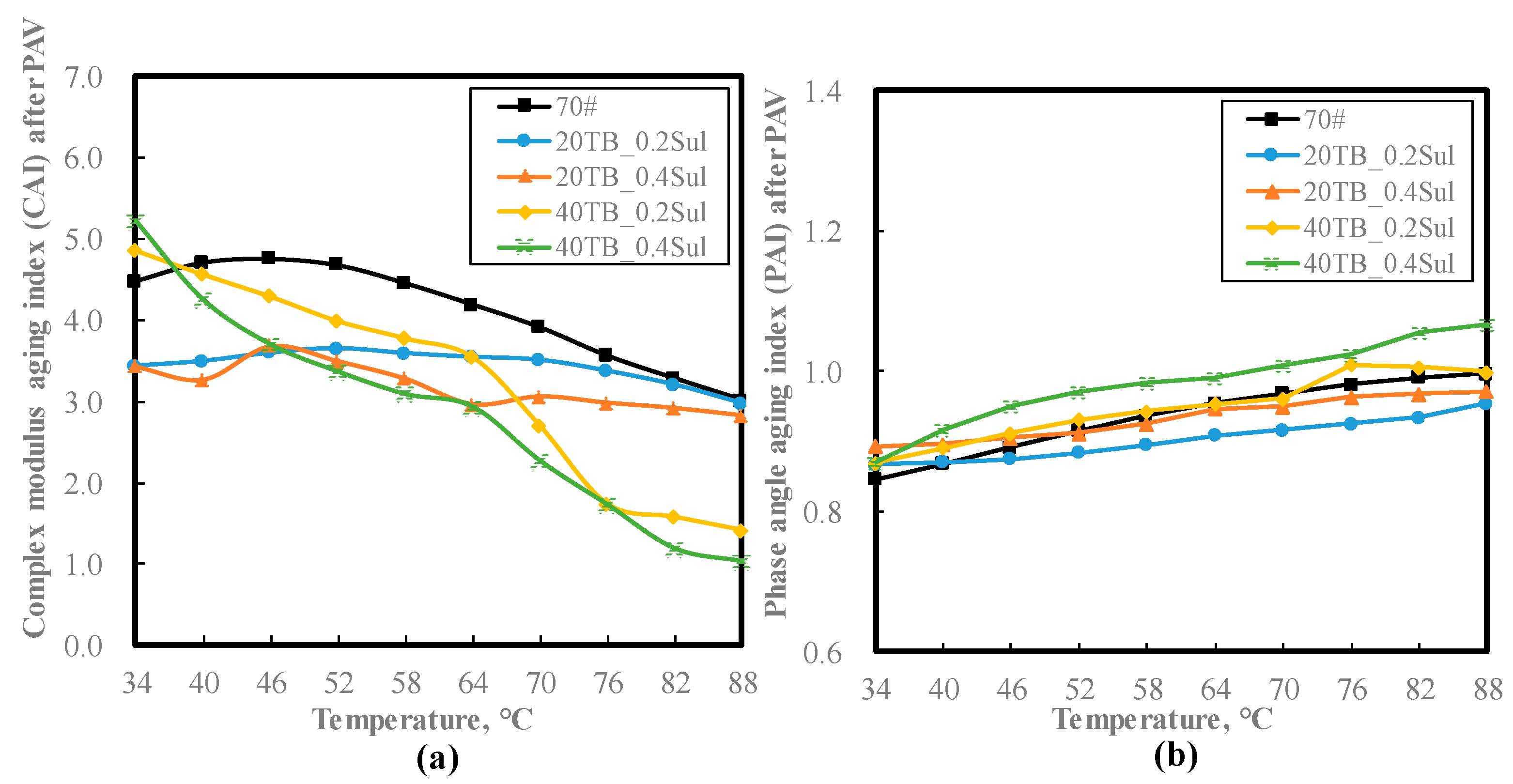
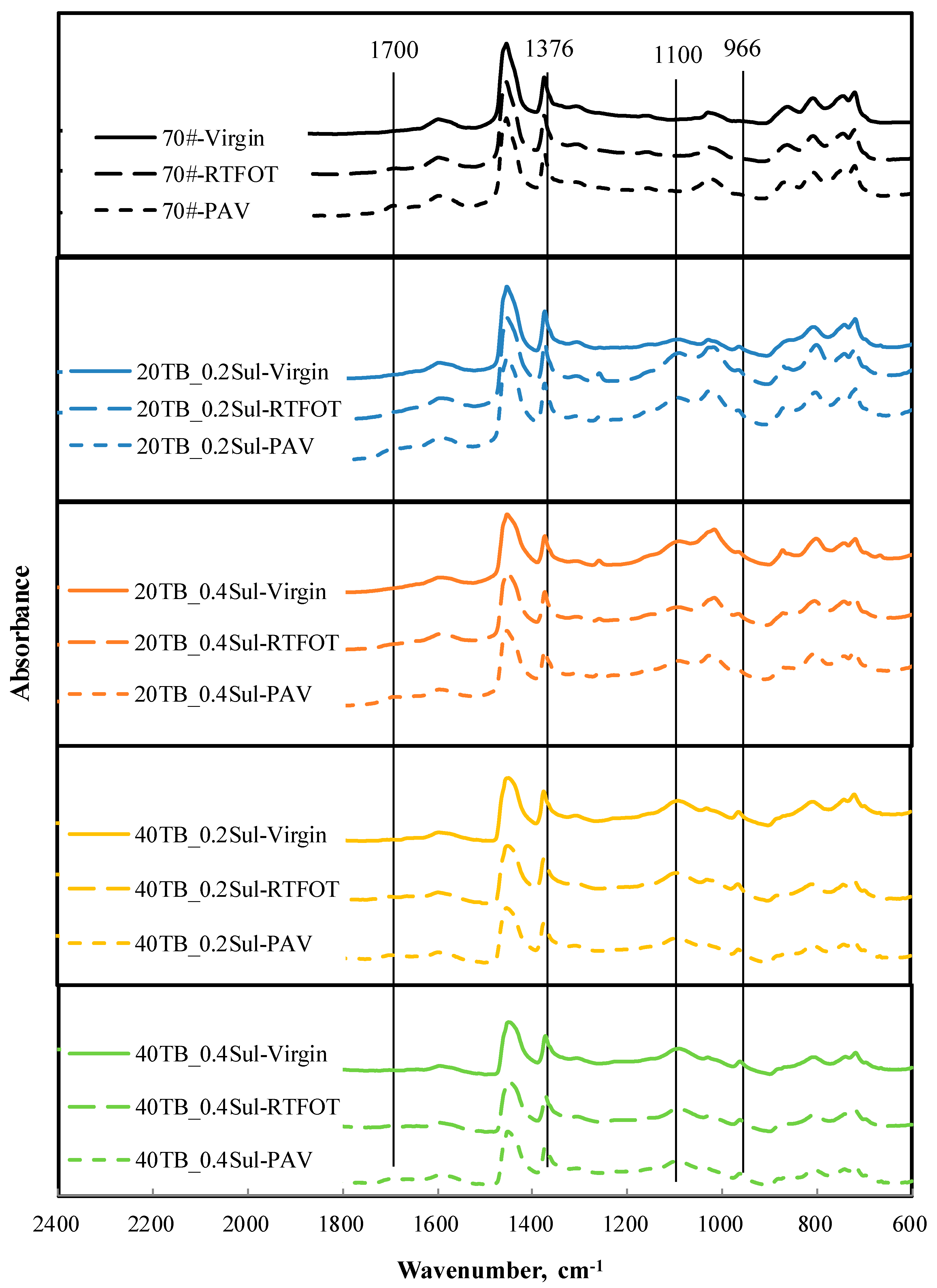
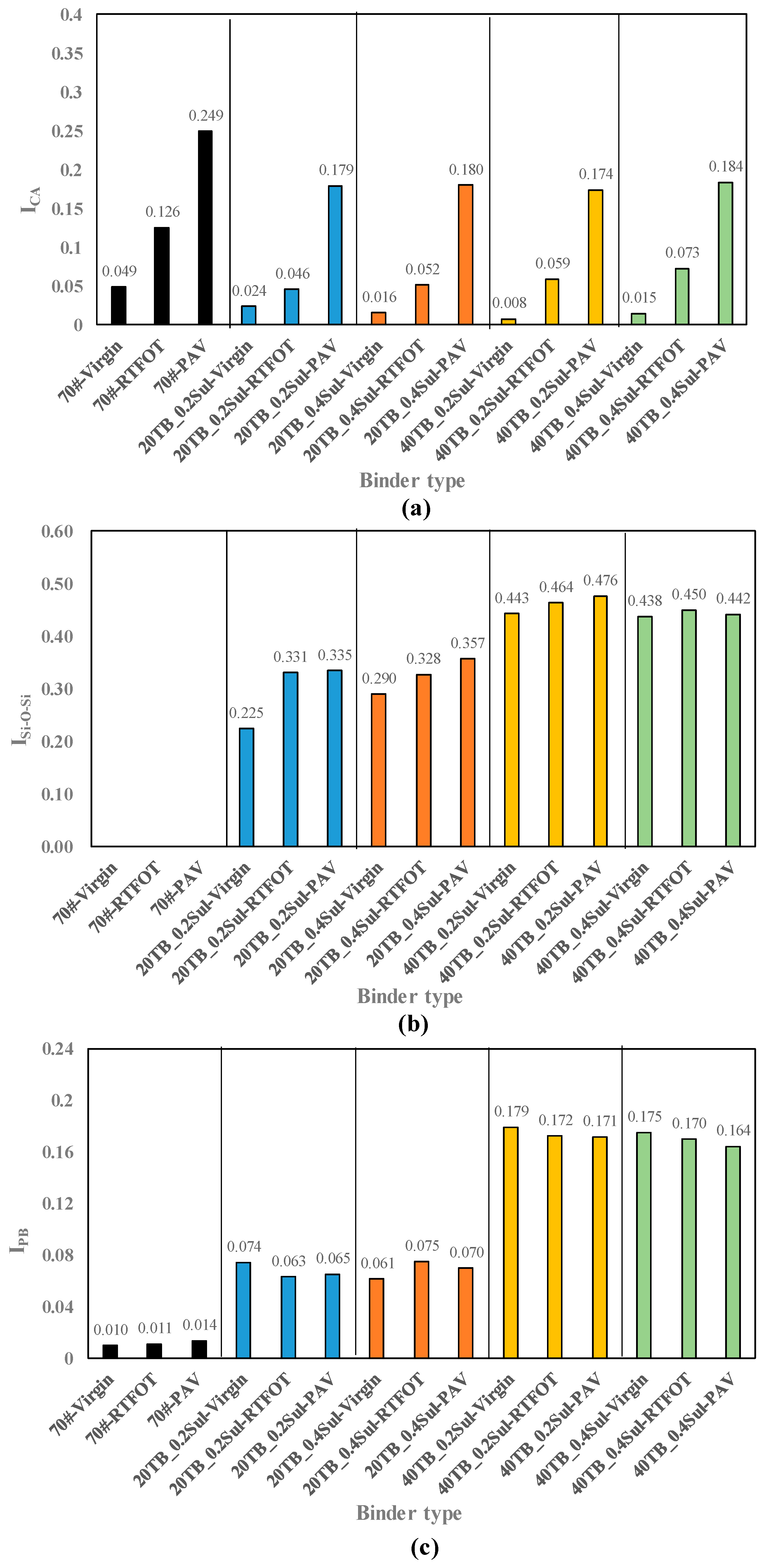
| Binder Type | Modification Plan | |
|---|---|---|
| Sulfur, % | CR, % | |
| 70# | 0 | 0 |
| 20TB_0.2Sul | 0.2 | 20 |
| 20TB_0.4Sul | 0.4 | 20 |
| 40TB_0.2Sul | 0.2 | 40 |
| 40TB_0.4Sul | 0.4 | 40 |
| Sample Name | The Logarithm of Frequency Corresponding to the Intersection Point, Hz | ||
|---|---|---|---|
| Virgin | RTFOT | PAV | |
| 70# | 2.079 | 1.680 | 1.112 |
| 20TB_0.2Sul | 2.289 | 1.834 | 1.569 |
| 20TB_0.4Sul | 2.210 | 1.766 | 1.348 |
| 40TB_0.2Sul | 3.587 | 3.508 | 3.045 |
| 40TB_0.4Sul | 3.598 | 3.246 | 2.641 |
| Sample | 70# | 20TB_0.2Sul | 20TB_0.4Sul | 40TB_0.2Sul | 40TB_0.4Sul | |||||
|---|---|---|---|---|---|---|---|---|---|---|
| ICA | ΔICA | ICA | ΔICA | ICA | ΔICA | ICA | ΔICA | ICA | ΔICA | |
| Unaged | 0.049 | 0.024 | 0.016 | 0.008 | 0.015 | |||||
| RTFOT aging | 0.126 | 0.077 | 0.046 | 0.022 | 0.052 | 0.036 | 0.059 | 0.051 | 0.073 | 0.058 |
| PAV aging | 0.249 | 0.200 | 0.179 | 0.156 | 0.180 | 0.164 | 0.174 | 0.166 | 0.184 | 0.169 |
| Sample | 20TB_0.2Sul | 20TB_0.4Sul | 40TB_0.2Sul | 40TB_0.4Sul | ||||
|---|---|---|---|---|---|---|---|---|
| ISi-O-Si | ΔISi-O-Si | ISi-O-Si | ΔISi-O-Si | ISi-O-Si | ΔISi-O-Si | ISi-O-Si | ΔISi-O-Si | |
| Unaged | 0.225 | - | 0.290 | - | 0.443 | - | 0.438 | - |
| RTFOT aging | 0.331 | 0.106 | 0.328 | 0.038 | 0.464 | 0.021 | 0.450 | 0.012 |
| PAV aging | 0.335 | 0.110 | 0.357 | 0.067 | 0.476 | 0.034 | 0.442 | 0.004 |
Publisher’s Note: MDPI stays neutral with regard to jurisdictional claims in published maps and institutional affiliations. |
© 2022 by the authors. Licensee MDPI, Basel, Switzerland. This article is an open access article distributed under the terms and conditions of the Creative Commons Attribution (CC BY) license (https://creativecommons.org/licenses/by/4.0/).
Share and Cite
Wang, S.; Huang, W.; Liu, X.; Lin, P.; Ren, S.; Li, Y. Effect of High Content of Waste Tire Rubber and Sulfur on the Aging Behavior of Bitumen. Appl. Sci. 2022, 12, 5417. https://doi.org/10.3390/app12115417
Wang S, Huang W, Liu X, Lin P, Ren S, Li Y. Effect of High Content of Waste Tire Rubber and Sulfur on the Aging Behavior of Bitumen. Applied Sciences. 2022; 12(11):5417. https://doi.org/10.3390/app12115417
Chicago/Turabian StyleWang, Sheng, Weidong Huang, Xueyan Liu, Peng Lin, Shisong Ren, and Yi Li. 2022. "Effect of High Content of Waste Tire Rubber and Sulfur on the Aging Behavior of Bitumen" Applied Sciences 12, no. 11: 5417. https://doi.org/10.3390/app12115417
APA StyleWang, S., Huang, W., Liu, X., Lin, P., Ren, S., & Li, Y. (2022). Effect of High Content of Waste Tire Rubber and Sulfur on the Aging Behavior of Bitumen. Applied Sciences, 12(11), 5417. https://doi.org/10.3390/app12115417









